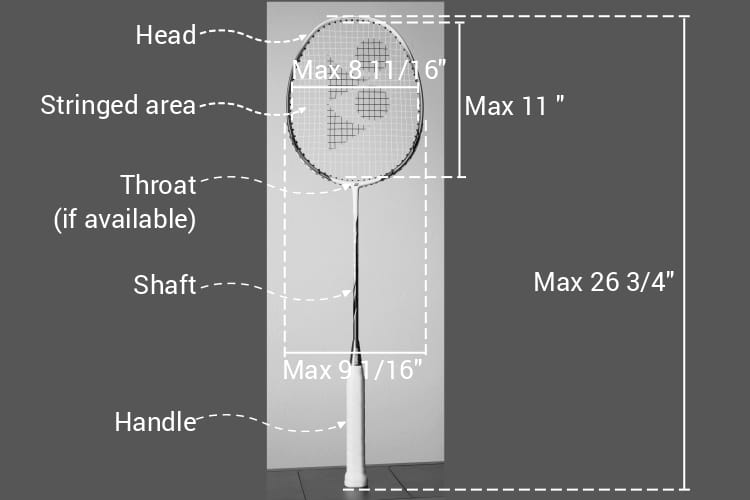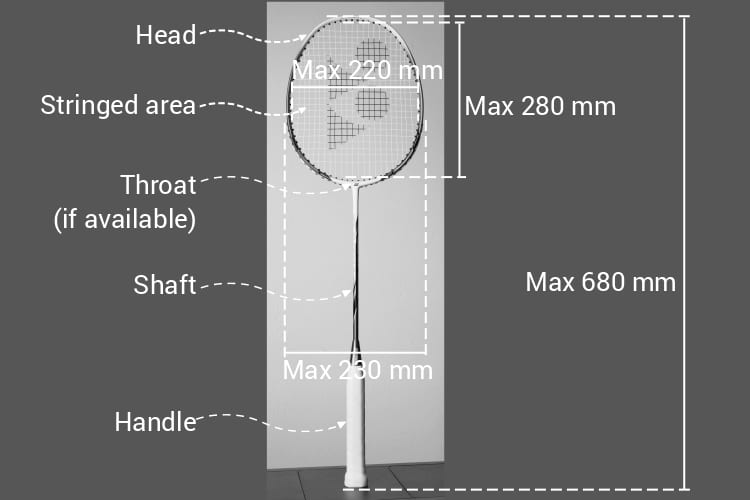The most important piece of equipment in badminton is the racket. With one swift motion, you can gently tap the shuttle and send it soaring over the net toward your opponent. But have you ever taken the time to think about each and every part of your badminton racket?
Badminton rackets look fairly simple, but they are actually very carefully designed. Most badminton rackets are between 665 and 675 millimeters in length. Every badminton racket includes the following pieces.
- Butt Cap
- Handle/Grip
- Shaft
- Throat
- Strings/Stringed Area
- Head
It is time to get to know your badminton racket a little bit better. In this post, I will be reviewing all the different parts of the badminton racket from bottom to top and what they are responsible for. Here we go!
Do you want to improve your badminton game? Then be sure to sign up for Badminton Famly+ by clicking here. Founded by former World Champion Thomas Laybourn, Badminton Famly+ is the best online training platform for badminton.
The Butt Cap
The butt cap of your badminton racket is at the very end of the racket. This is the small piece of plastic material that easily slips on and off. It usually will have a logo at the bottom that comes from the manufacturer.
Even though it might seem bothersome at first, the butt cap does play a very important role in your gameplay. The butt cap helps to keep the racket gripped firmly in your hand. The larger the butt cap, the better grip you will have. That translates over to more power and accuracy when playing badminton.
The Handle/Grip
The handle or the grip of your badminton racket is the part you will be holding when you are in a match. Not only does it tell you where you are supposed to hold the racket, but it also helps to keep your hands and wrists comfortable.

The grip is usually made of polyurethane material and will keep your hand cushioned while you are smashing the shuttle. This becomes very useful when you find yourself in a long rally or extended matches. It can also help to absorb sweat and keep your racket from flying out of your hand during a long match. That also means you have a smaller chance of getting blisters.
In addition to the grip that comes installed on the racket, there is also what is called the overgrip. This is an extra grip that is installed on top and that is replaced periodically. There are two main types:
- PU (polyurethane) overgrip: This is the most common type of grip on a badminton racket. This type of grip is very thin and slightly sticky. The stickiness will help you to keep a firm grip, even when your hand is becoming sweaty. Due to its low maintenance, this is the most recommended overgrip for beginners.
- Towel overgrip: This is a much thicker grip that is actually made of cotton, like a towel. It is very comfortable in your hand and will absorb a lot more sweat. It has a downside, though. Because of the material, it needs maintenance and care, and you need to replace it more often. Because of these things, it is recommended for advanced players only.
The length of the grip will also be very important. A longer grip usually will give you better power behind your shots. On the other hand, a shorter grip is ideal if you want better control of your swings.
If you want to learn a bit more about the badminton grip, be sure to check my Badminton Grip Guide, where we talk about the different types of grip and our product recommendations in much more detail.
The Shaft
The shaft is the thin and long piece of metal that connects the handle/grip to the head of the badminton racket. The stiffness and the flexibility of the shaft can vary much impact your gameplay.
A flexible shaft will bend slightly when you are attempting a powerful smash or hit. The more flexible the shaft is, the more rebound and power you can get behind a shot. This is a good choice for beginners looking to build power and speed.
A stiff shaft is a better choice for advanced players. Since the shaft will not really bend when smashing or hitting the shuttle, you have much better control of where you are placing your shots. This is the best choice for accuracy and quick shots.
The Throat
The throat or the heart of the badminton racket is what connects the shaft to the head. In some rackets, this is a separate piece of metal designed in a T-shape to fuse these two pieces of the racket. Newer rackets might not have a separate throat at all. You will probably find a visible throat in rackets made for beginners.
The Strings (Stringed Area)
The strings or the stringed area of the racket must be within BWF guidelines. That means it should be no longer than 220 millimeters (8 11/16″) wide and 280 millimeters (11″) long. The nylon or carbon strings are usually very elastic and intertwined into a grid shape. The strings are woven and tied tightly upon their exit from the head of the racket, connecting these two areas.

The thickness of the strings is important to think about. They usually range in thickness between 0.62 millimeters (thin) and 0.70 millimeters (thick). This is usually referred to as the “gauge.”
Thicker strings will typically be more durable and give you a lot more control and precision with your shots. Thinner strings are ideal for building power and are most often used by the professionals.
Also important is the tension of the strings in the string bed. Here is a look at how the tension can change your gameplay indefinitely.
- 16-21 pounds (low tension): This tension is meant for beginners and low-intermediate players. It will give you much more power behind your shots without putting in very much effort. The downside is that low tension strings are not the best for accuracy.
- 22-32 pounds (high tension): This tension is meant for more high-intermediate and advanced players. When you use all the power you have, you will be able to pull off a very powerful shot. It also can help with accurate shots too.
The difference in gameplay because of string tension comes down to the “sweet spot.” This is the area of your string bed that will provide you with the greatest amount of power and accuracy.
The tighter the strings, the smaller the sweet spot. That is exactly why low tensions strings are better for beginners. It gives them a larger sweet spot and more power and accuracy.
The Head
The head of the badminton racket is the top metal frame that encases the string bed. This is an important piece of a racket when it comes to building power behind your strikes and hits.
The first thing that will impact your gameplay is the actual shape of the frame.
An isometric head is symmetrical, so it has a much larger and more even sweet spot. This is the shape recommended for beginners. The next type is an oval-shaped head. This type has a smaller sweet spot but, if you are able to hit the shuttle in the sweet spot, the shots become more powerful. This is the shape recommended for upper-intermediate and advanced players.
The weight of the head will also change how your game goes.
A badminton racket with a heavy head will give you a lot more momentum, so this type is better if you are looking to build momentum or a powerful shot. The problem is that this type of racket will not be good for defensive tactics and quick shots.
A light head on a badminton racket is best for defense. You will not be able to produce as powerful of a hit, but you can respond quickly and have pretty good control over your smashes and your hits.
Final words
Every single part of a badminton racket is important in deciding your style of gameplay. That is exactly why you need to be strategic when it comes to buying your brand new badminton racket. It is important to analyze the characteristics of each and every part to see that it works best for your playing style.
